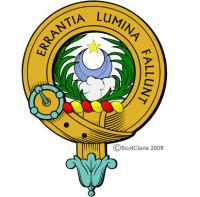
Clan Kinnaird
Originates in the barony of the same name in Perthshire. The first of the name on record is Radulphus Ruffus who received a charter of the lands from William the Lion around 1180. There is a record of a royal confirmation (1204 - 1214) of a grant by Richard of Kinnaird, grandson of Radulphus. Rauf de Kynard signed the Ragman Roll, pledging his allegiance to Edward I of England at Kincardine in 1296, and Richard de Kynnard of Fife rendered homage to the English king in the same year.
William de Kynnard was a notary of St. Andrews diocese in 1430, Thomas de Kynnard was a charter in 1431,and Andrew de Kynharde was a charter witness in Dundee in 1435.
Alan de Kynnard granted a charter of the lands of Hill in 1449, and William Kynnard of that Ilk is mentioned in 1546.
Charles II knighted George Kinnaird of Inchture for his loyalty during the civil wars, and then went on to make him Lord Kinnaird of Inchture in 1682.
The third Lord Kinnaird, Patrick, was very open about his opposition towards the unification of the Scottish and English parliaments in 1707, before his death in 1715.
George Kinnaird (1754-1805), the seventh Lord, was a representative peer in the House of Lords, and his brother was friends with noted poets Percy Shelley and Lord Byron, and he also helped to manage Drury Lane Theatre in London.
Arthur Kinnaird, the 11th Lord Kinnaird, born in 1847, was a prominent figure in the early years of the Football Association having been a committeeman, treasurer, and for 33 years, the president. He was also a player of the sport, and has appeared in a record nine F.A. Cup finals.
Outwith football, he was also the president of the English Y.M.C.A., a director of Barclays Bank, and was Lord High Commissioner to the General Assembly of the Church of Scotland between 1907 and 1909.







